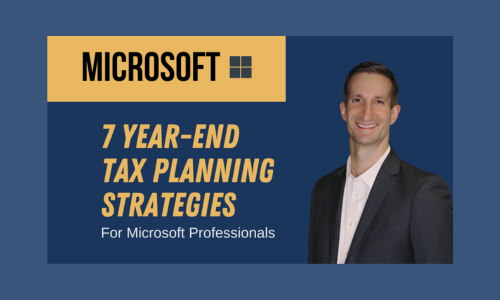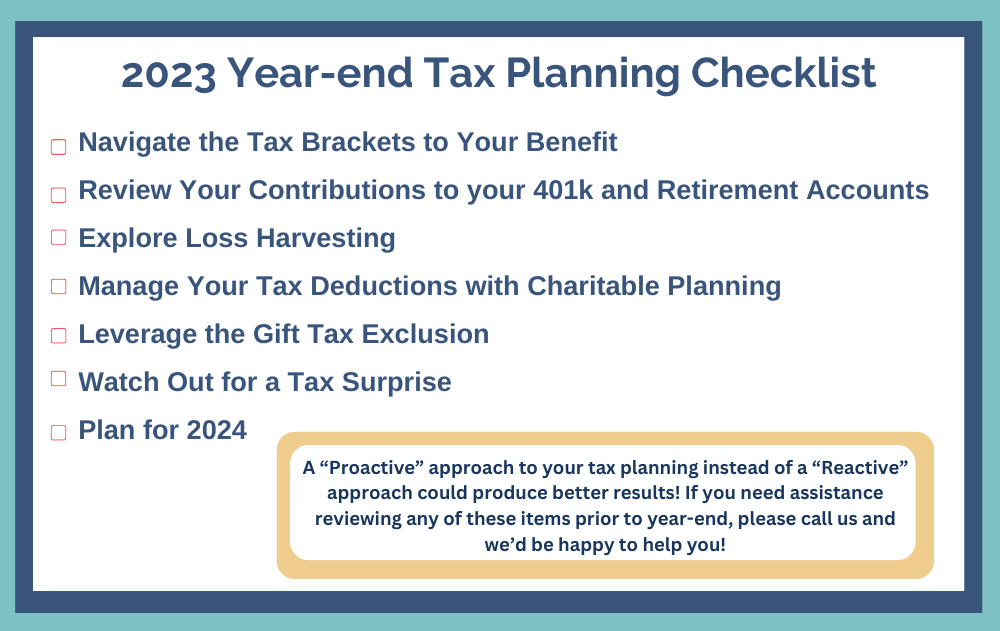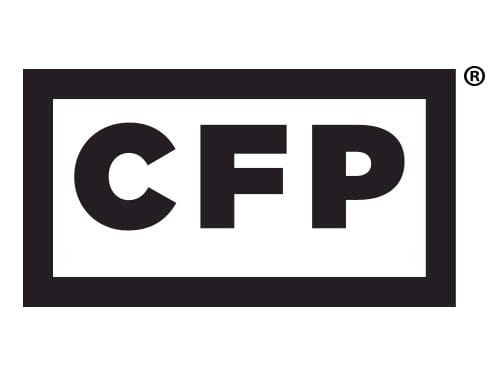7 Year-End Tax Planning Strategies for Microsoft Professionals

As we transition into the fall, this is a prime opportunity for Microsoft Professionals to review year-end strategies that can reduce their taxes. While having the right investment and savings plan is crucial, at the end of the day what really counts is the amount of your earnings that you get to keep after taxes are taken out. Therefore, this is a great time to take a forward-looking approach and map out actions you can take now to increase your bottom line. This guide highlights critical year-end tax planning strategies tailored for Microsoft professionals. We have also included below a video summary that highlights the key points of the article.
1. Navigate the Tax Brackets to Your Benefit
It all begins with projecting the tax bracket you are in, so you can plan around it wisely. For instance, if your family’s gross income is $350k, you likely have $50k or so of room in the favorable 24% tax bracket. This creates a good opportunity to consider a Roth conversion for example, where you move funds from your traditional pre-tax IRA to your Roth IRA and pay tax at the favorable 24% tax bracket. Yes, even for those working this could be a great tool! Conversely, if your gross income is $450k, you may want to go the other way and look to reduce your taxable income to remain in the 24% bracket by enhancing your itemized deductions, for example considering a contribution to a Donor Advised Fund (more on this later!).
Contrary to popular belief, always driving taxable income down isn’t necessarily the best approach. Assess your current tax bracket and compare it to your potential future bracket. In many instances, the current favorable tax landscape will result in Microsoft professionals being in a lower tax bracket today compared to retirement.
This especially rings true today with the current favorable tax rates expected to sunset in 2026 and revert to the 2017 tax rates. For many this will result in as much as a +9% increase in marginal tax rate at the same level of income. This change paired with the ongoing possibility that Washington will implement a state income tax in the future, makes it an ample time to utilize the current favorable tax rates. Furthermore, traditional strategies such as deferred compensation plan contributions may not be the appropriate decision for many in this environment.
2. Review Your Contributions to your Microsoft 401k and Retirement Accounts
Microsoft professionals should regularly review their 401k and other retirement contributions. If you aren’t on pace to max out your contributions for the year, consider increasing your contributions to do so to take advantage of the tax benefits. Additionally, you are not confined to the $22,500 ($30,000 if over 50) contribution limit. Microsoft’s 401k offers the Mega Backdoor Roth feature where you can contribute an additional $32,250 into the after-tax part of your 401k in 2023, which Microsoft then immediately converts to a Roth without any additional tax.
3. Explore Loss Harvesting
If you hold any non-retirement stock or investment fund shares at a loss, consider selling these shares to realize a tax loss that can offset other capital gains as well as up to $3,000 of ordinary income. You can then reinvest the sale proceeds into a similar or more diversified investment. For example, if you own Microsoft shares that are at a loss you can consider selling those specific shares to both achieve the tax loss harvest benefit as well as reinvest into a different holding to diversify your Microsoft exposure.
If you do wish to buy back the same investment you sell, be careful of the IRS’s “wash sale” rule, in which you must wait 31 days to repurchase the same investment to benefit from the tax loss harvest.
On occasion, it can make sense to sell some stock that will result in capital gains. We commonly come across Microsoft employees that are wary to sell their appreciated stock to avoid the tax hit. It is important to remember that long-held stocks (>1 year) benefit from a lower capital gains tax rate. Additionally, if your gross income is under $554k for a couple, you fall into the even lower 15% capital gains tax rate. Ongoing stock sales within this favorable rate can help you stay within a manageable tax bracket, while also diversifying your investment risk.
Given the various moving parts, you may consider consulting with your Financial Planner prior to implementing these strategies.
4. Manage Your Tax Deductions with Charitable Planning
If in a situation where you are looking to reduce your income to stay out of a higher tax bracket, a strategy called “bunching” your itemized deductions can be a good way to go. What this means is showing more itemized deductions in higher income years where the tax savings are greater. One way to go about this is timing your charitable deductions. Instruments such as donor-advised funds can be great tools in this regard. The way this works is you can set up a Donor Advised Fund (DAF) investment account that you then control like your other accounts. When you contribute to this account you receive a charitable deduction for tax purposes. The neat aspect is you can then decide when to distribute the account to the charities of your choosing over your desired timeline. This is a great way to get the tax benefit of contributing multiple years of giving to the DAF now, and then disbursing it to the charities over several years.
Another benefit of the DAF is you can fund it with appreciated stock or investments. By doing so you still receive the itemized deduction from your taxes though you also don’t pay the capital gains tax on the stock appreciation! For example, you can transfer $30,000 of low basis Microsoft shares into a DAF and avoid the capital gains tax completely while also receiving the tax deduction on your tax return.
However, be cautious when funding these gifts with stocks or investments held for less than a year. Donating short-term investments can make the accrued gains taxable at the time of donation.
5. Leverage the Gift Tax Exclusion
Gifting isn’t just about spreading love; it can be a strategic move to save future taxes as well. In 2023, the Gift Tax Exclusion allows up to $17,000 to be gifted tax-free per beneficiary this year. This is the amount that you can give to family or other individuals each year tax-free without any reporting requirement. These gifts do not reduce your lifetime estate tax exemption amount, nor do they require the filing of a gift tax return. This $17,000 cap doubles for jointly owned properties or through “gift-splitting”, allowing married couples to combine and give $34,000 for each beneficiary.
With the lifetime federal estate tax exemption amount due to revert to about $7 million per a person in 2026, this ongoing annual gift approach can be instrumental in effectively reducing future estate taxes. Furthermore, in the state of Washington we have a state estate tax that kicks in on estates sized over $2.2 million per a person at the time of death.
For couples that may not be ready to make gifts of this size to children or family members, making the gifts to a trust can also be a good option. These gifts often qualify as annual exclusion gifts if the gift is direct and immediate. A gift that meets all the requirements removes the property from your estate. The annual exclusion gift can be contributed for each beneficiary of a trust, for which you can then serve as the trustee and continue to manage the funds for their benefit.
6. Watch Out for a Tax Surprise
Throughout the course of the year there are several taxable activities that can catch Microsoft professionals off guard and result in a tax surprise. The major one is taxes due on your RSU Stock Award vests. As your RSUs are taxable when they vest, the federal guideline is to withhold 22% for taxes. Many Microsoft Professionals are in a much higher tax bracket than this, resulting in the potential for a tax shortfall. Regularly reviewing your tax payments throughout the year helps in planning for any potential shortfalls, avoiding surprises and penalties during tax filing.
Another surprise that will sneak up on many people this year is the interest earned in your savings accounts. After over a decade of near zero interest rates, cash savings vehicles are now earning more than 5% annually. For those holding significant cash balances this can result in sizable tax liabilities to plan for.
7. Plan for 2024
This is also an ideal time to map out a game plan for 2024. By putting together a 2024 tax projection now, you can determine if appropriate to elect to make any contributions to your deferred compensation plan for 2024, as well as outline your 401k and investment account contribution strategy. This will go a long way towards helping you maximize your tax savings for next year.
In Conclusion
Tax planning is more than just a yearly chore; it is a cornerstone to maximize your wealth and fast-track your path towards work optionality. While these 7 strategies offer a great starting point, understandably they can also be daunting. If you’re feeling overwhelmed or just too busy, the good news is you don’t have to tread this path alone. At Stabler Wealth Management we are just a call (or click!) away and here to help you apply these strategies effectively. Don’t hesitate to schedule a meeting with us here or reach out directly via team@stablerwm.com | (425) 646-6327.

Contact Us:
team@stablerwm.com | (425) 646-6327
Traditional IRA account owners have considerations to make before performing a Roth IRA conversion. These primarily include income tax consequences on the converted amount in the year of conversion, withdrawal limitations from a Roth IRA, and income limitations for future contributions to a Roth IRA. In addition, if you are required to take a required minimum distribution (RMD) in the year you convert, you must do so before converting to a Roth IRA.
A Roth IRA offers tax deferral on any earnings in the account. Qualified withdrawals of earnings from the account are tax-free. Withdrawals of earnings prior to age 59 ½ or prior to the account being opened for 5 years, whichever is later, may result in a 10% IRS penalty tax. Limitations and restrictions may apply.
No strategy assures success or protects against loss. Stabler Wealth Management and LPL Financial are not affiliated or endorsed by Microsoft.
This material was created for educational purposes only and is not intended as ERISA, tax, legal or investment advice. If you are seeking investment advice specific to your needs, such advice services must be obtained on your own separate from this educational material.
Securities and financial planning services provided through LPL Financial, a Registered Investment Advisor. Member FINRA/SIPC.
Category
Stay Informed
Join our mailing list to receive monthly newsletters with information that impacts your financial decisions.

Certified Financial Planner
In Business 35+ Years